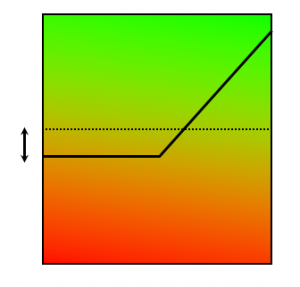A question from a RadioActiveTrading follower…
“What I’m trying to get clear on is the net dynamics of the married put vs. a stop loss (acknowledging the risks of stop losses not functioning properly). The cost of “insuring” that losses stay single digit with RPM is that you (a) increase the progress any particular stock has to make in order to make the position a winner and (b) give up some of the upside when you are right since these positions seem to have initial deltas in the 0.3 to 0.4 range.”
Mike Chupka’s thoughts…
During some of the webinars Kurt will point out that in a 12 month time frame (I think in 2010) I had an RPM winner with a gain of 59.8%, and the biggest loss I took that year was 4.5%. The stock that I lost 4.5% on dropped more than 50% of it’s value over a 3-4 month period, following a gap of 20% decline. I stayed in the stock because I thought it would recover, but it never did. But, if I had been using a stop order on that trade instead of a married put, I would have been filled at 20% loss at exit without further input. If I bought back into the stock and it continued down, I would have lost again, and then again once I got stopped out (again, thinking the stock would recover).
I was much happier simply taking the 4.5% loss rather than compounding the loss over a 3-4 month period to 30% or so, which likely would have negated most of the 59.8% gain.
Okay, but what about a stock that just drops 7-8% in the first 30 days and we hit our stop loss and close out of the position? Well, remember, if you just bought the stock and it dropped 7% and triggered a stop, you would still lose only 3% or so on the married put position as your put option would be gaining in value.
So now the debate becomes what about hindering the upside with the cost of the put? When I pull up the default RadioActive Search on PowerOptions, the delta range for the position results is from -0.49 to about -0.62. On average I would say the deltas for the put options I use are between -0.50 and -0.65, resulting in a positive delta of the married put position of 0.50 to 0.35. Yes, I am giving up some positive delta for the benefit of guaranteed insurance (put option) vs. assumed insurance (stop order). We’ve generally been able to participate in 50% or more of the upside when the stock does what we expected and goes up.
The notable thing here is that I can apply the income methods to reduce this delta gap (though I never really pay attention to delta when I am opening a new RPM), and also that I know if the stock moves up 1% in the next day, I am likely to still have an unrealized 0.4 – 0.6% profit. The far out options tend not to behave exactly on the delta as there is always a lag of the put option reacting with normal stock movements and that I always try to use mid-point pricing to reduce slippage as much as possible. These are just my thoughts on why I moved away from straight stock, covered calls, naked puts and spread trades over time. I always seemed to be treading water due to large of losses even when stop orders were in place.

 I'm Kurt Frankenberg, and I have discovered how to truly put the odds on the side on the individual investor.
I'm Kurt Frankenberg, and I have discovered how to truly put the odds on the side on the individual investor.
Make sense to me. …But, couldn’t they (stop triggers) still be used effectively on stocks and ETF’s that do not trade after hours?